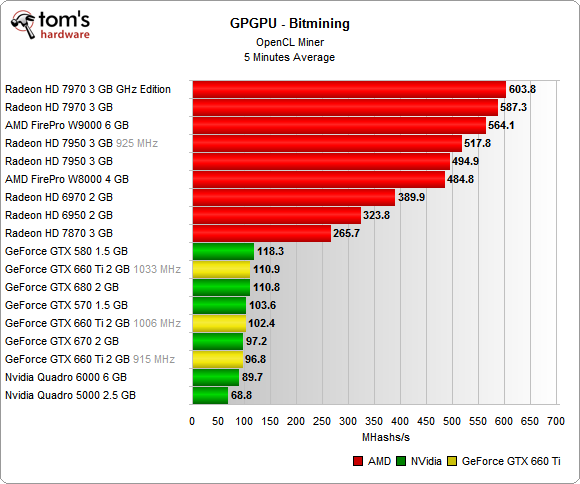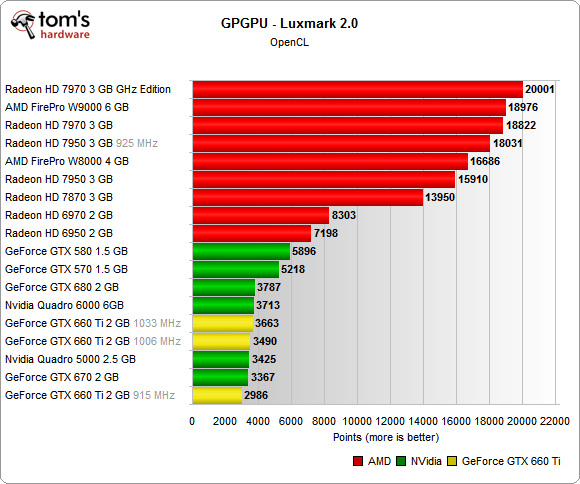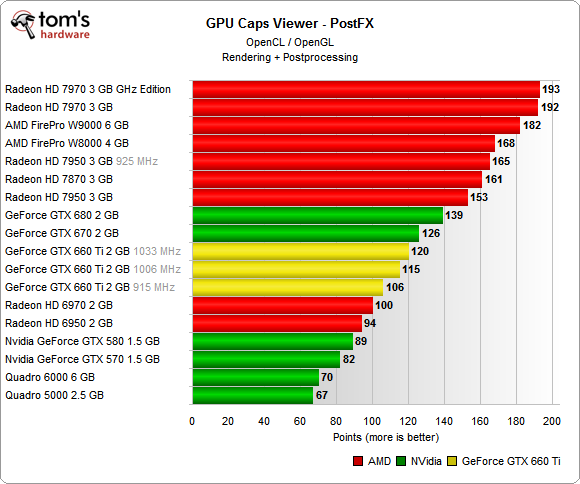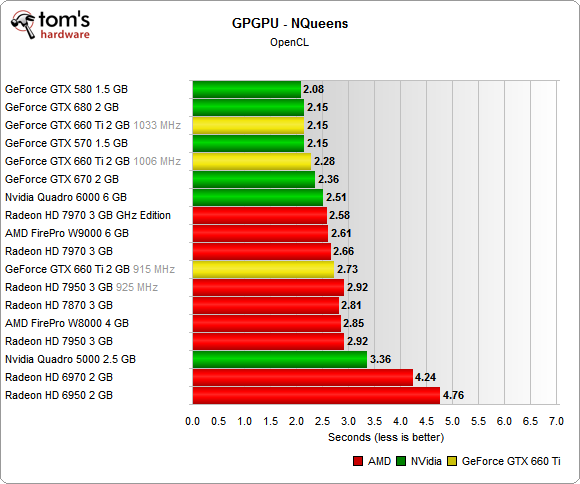GeForce GTX 660 Ti Review: Nvidia's Trickle-Down Keplernomics
Nvidia's Kepler architecture is finally manifest in a $300 graphics card, which the company says beats AMD's Radeon HD 7870 and challenges its more expensive 7950. Can this GK104-based mainstream card carve out a spot between the GCN-based competition?
OpenCL: GPGPU Benchmarks
Overall, OpenCL-based tests are far less friendly to Nvidia's desktop GK104-based cards than the games. In order to add more data, we're including the workstation-oriented products we just finished testing on the same machine, as well as previous-generation desktop boards. Depending on the application, its workload, and driver optimizations, the outcome can change dramatically. There are still a handful of obvious trends, though.
We list three different settings for the GeForce GTX 660 Ti, which correspond to clock rates we're told will be available at retail. Incidentally, we're currently working on a round-up of GTX 660 Ti cards, and all three speeds will appear there as well. We also re-tested AMD’s reference Radeon HD 7950 flashed with the "GHz Edition" firmware.
AMD’s consumer and workstation cards dominate the field in Bitcoin mining and SHA-256 hashing. Clearly, if this is a workload that keeps your graphics hardware hammered all day and night, the GeForce GTX 660 Ti is not for you. Even the most aggressive overclock sees the new board fall short of Nvidia's old Fermi-based GeForce GTX 580.
We purposely chose LuxMark 2.0's simpler rendering workload. Otherwise, the weaker cards from Nvidia would have given us even shorter bars, making them indiscernible. However, the GeFore GTX 570 and 580 enjoy more pronounced leads as the scene's complexity increases.
The PostFX test combines OpenCL and OpenGL in one demanding workload. Although this benchmark is taken straight from Nvidia’s SDK, it’s also an impressive example of how quickly the performance story can change in the fact of a new architecture like GCN.
Finally, Nvidia's Kepler-based cards exhibit a stronger showing. But again, it's the company's previous-gen architecture that comes out on top.
Get Tom's Hardware's best news and in-depth reviews, straight to your inbox.
Current page: OpenCL: GPGPU Benchmarks
Prev Page Overclocking Next Page OpenCL: GPGPU Benchmarks (Basemark CL)Don Woligroski was a former senior hardware editor for Tom's Hardware. He has covered a wide range of PC hardware topics, including CPUs, GPUs, system building, and emerging technologies.
-
game junky Hmm. I have been wanting to replace my 560 - this throws a wrench in the gears. I was sold on a ASUS 670 but I think I'll wait to compare specs with their 660ti - I just started ripping my BD collection so the additional RAM bandwidth might be worth the extra $100 but it is still an interesting option.Reply -
crisan_tiberiu so, this is basically a card that costs 40$ less then a GTX 580, consumes 100W less power then a gtx 580 and its 8% better...hmm, intresting.Reply -
rmpumper That's strange - on techpowerup review the 660Ti is above 7950's average performance.Reply -
outlw6669 game junkyI was sold on a ASUS 670 but I think I'll wait to compare specs with their 660ti.Asus' DCU2 Top ends up about 5% faster than stock, 8% slower than stock GTX 670 and still uses that excellent cooler.Reply
http://www.techpowerup.com/reviews/ASUS/GeForce_GTX_660_Ti_Direct_Cu_II/1.html
Still, the GTX 660Ti looks to be a decent card.
Not really fond of how nVidia keeps nerfing their memory bandwidth though.
Once prices drop a little, I could see it being an excellent mainstream card. -
verbalizer nice card, not OVERLY impressed...Reply
BUT THE PRICE...!
c'mon SON let's be real here......
ridiculous @ $300 beans.. -
felipetga I have been holding to upgrade my GTX 460 256bits. I wonder if this card will be bottlenecked by my C2Q 9550 @ 3.6ghz....Reply -
verbalizer GPGPU = Kepler = FAIL....Reply
that's depressing but I understand nVidia has designated GTX 6 series as a gaming cards but c'mon SON.!!!
ridiculous once again.. -
EzioAs Clearly we need more price cuts on the 660ti. I expect AMD to lower the prices even more, heck online retailers sell Radeon cards lower than the MSRP, making 7950 and 7870 even more budget friendly. It's still sad really to see mid-range cards battling at $300+. It used to be $250 and lowerReply



